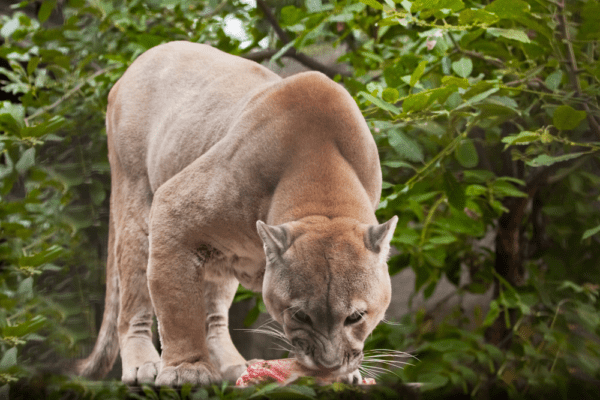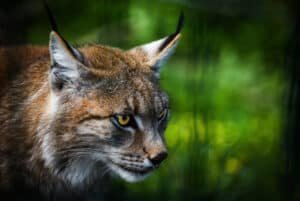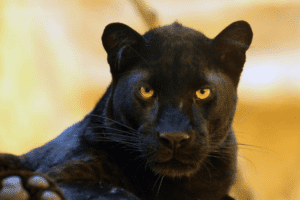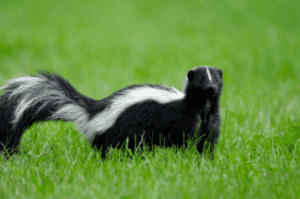Cougars are magnificent creatures with many myths and cultural significance. Although it is self-evident that cougars are excellent predators but the question would probably arise in your mind “what do cougars eat? And how much do they consume?
Is it capable of going without food for long periods? What happens if a cougar’s food supply is limited? We’ll discover the answers to those queries in this article.
Table of Contents
Taxonomy
Cougars (Puma concolor), commonly known as catamounts, pumas, and mountain lions are carnivores that eat only meat. They are members of the Felidae family. After the jaguar (Panthera onca), the cougar is the world’s 2nd largest cat.
Cougars have the most in common with jaguarundis and cheetahs. Despite their size, cougars are more closely associated with lesser felines, than with any other Pantherinae species.
Morphological identification
The cougar’s head is round, and its ears are upright. Cougar coloration is simple, hence the Latin word concolor, which means “one color,” but it varies significantly across individuals, including closely related species. Blue eyes as well as rings on their tails are seen in newborns.
Cougars have enormous feet and the biggest hind legs in the Felidae family, allowing them to leap and sprint quite quickly. It can leap up to 5.5 meters into a tree from the ground.
General behavior
The cougar, like almost all cats, is mainly mysterious and solitary by nature. It is correctly classified as both nocturnal and crepuscular, however diurnal sightings can occur. Adults rarely meet, but moms and kittens dwell in groups.
Cougars, despite being loners, frequently exchange prey with one another and appear to arrange themselves into tiny groups defined by dominant males’ territories. Cougars are territorial and like to live in small groups.
Individual niches are determined by geography, vegetation, and prey abundance. Cougars spend their entire lives looking for food and can travel up to twenty-five miles in one night. Cougars walk at a half-mile per hour and can travel ten miles in a few hours even on rocky, hilly terrain. Cougars are opportunistic eaters who will devour anything that comes their way.
Cougars Diet Consists of :
Large Mammals
Cougars consume a range of huge animals, but deer appear to be their favorite because they catch them the most often. Cougars enjoy a variety of deer species, but their favorites include mule deer, white-tailed deer, and elk.
Small vertebrates
Cougars also hunt smaller animals if ungulates are not available. Rabbits, rats, porcupines, foxes, mice, and raccoons are among the smaller creatures that these cats enjoy hunting and devouring. Beavers are thought to be one of their palatable little animals to consume. Cougars have also been observed eating birds that are either already on the ground or flying low to the ground.
Small carnivorous
If they are particularly hungry, cougars will also hunt other predatory species such as coyotes. Domestic animals such as cats and dogs may also become their prey.
Arthropods
Cougars enjoy eating insects as well. In difficult environments where there isn’t much food available, insects are a valuable source of protein. They might come across grasshoppers, beetles, crickets, and a few more sorts of insects.
Dead animals
These creatures prefer fresh kills and flesh, but if they cannot make a kill themselves, they may eat carrion meat. Cougars have been observed taking over the carcasses of other predatory animals, and they may even hunt other predatory creatures while doing so.
Unexpected fact about its diet

Cougars’ main dietary variation is that they occasionally eat insects. Other foods, such as plant matter, are indigestible to these animals. They will starve if there are no animals to eat. However, cougars and other cat species have been seen chewing on the grass on seldom occasions.
The cause of this behavior is still unknown. Cats, according to others, just prefer the taste and texture of grass. Others feel that grass provides them with the folic acid they require. Some people believe that cats nibble on the grass to help them throw up and get rid of uncomfortable stomach problems.
Diet requirements
Cougars do not require daily feeding. An adult cougar may survive on a deer for up to sixteen days in the winter and three weeks in the summer. A cougar with kittens to feed needs to kill a deer once a week to keep them neutered, but cougar deer killings are rare compared to human hunting. Cougars have been known to consume up to thirty pounds of meat at a time.
A deer can be consumed entirely by a mother and her kittens. During the winter, cougars store food by leaving deer under mounds of snow for later meals. Males travel off for days at a time to obtain more food, while females stay closer to their young. Cougars only leave a few bones, skulls, and hoofs behind after they kill a deer.
Most prominent Prey competitor
Murphy et al., (1998) found an interesting fact that ungulate carrion caused by cougar predation is nutritionally essential to grizzly bears and black bears in specific areas and seasons. Cougars chased away by bears lost an average of 0.64 kg of ungulate biomass per day, or 17-26% of their daily energy requirements.
When predicting or measuring cougar predation rates, they even gave caution to biologists that they should keep in mind that scavenging losses can be severe for conservation.
Feeding Behavior
Surprisingly cougar is a tertiary consumer as it also consumes smaller carnivores such as foxes and wolves. The mean weight of cougars’ larger prey increases with body weight and is lower in places closer to the equator. Ungulates, particularly deer, accounted for 68 percent of prey items in a North American study. Only the Florida panther differed from the others in that it preferred feral hogs and armadillos.
According to Ruth and Murphy (2010), the feeding preferences of cougars are similar to wolves with those the cougar competes for resources. Ungulates accounted for more than 99 percent of the cougar diet. Some evidence was found cougars killed bighorn sheep only seldom, while others relied significantly on them. Their specific diet is determined by where they dwell in the world and the topography of their habitat. Cougars are ambush predators who hunt a wide range of prey.
Ackerman et al., (1984) studied 239 cougar cats and discovered that the most palatable diet for cougars is Mule deer (Odocoileu hemionus), which accounts for 81 percent of their diet. Another interesting fact he discovered about cougars is that the deer’s age is important, as they prefer to prey on deer of 7 years.
Mode of prey

Cougars normally kill by leaping onto their prey’s back or side and biting through the neck or twisting and snapping the neck with their massive leg muscles. They try to bite the back of the neck with a lethal bite from behind. When a huge animal is killed, they transport it to a remote location, cover it in debris, and eat it for days. Cougars sleep and feed near the carcass throughout this period.
The cougar, despite its speed, is mostly an ambush predator. Before springing onto the back of its target and suffocating it with a neck bite, it sneaks through plants and trees, ledges, and other hiding spots. The cougar may break the neck of some of its smaller prey and drag it to the ground with a strong bite and force.
The cat drags a kill to a favorite spot, hides it with the brush, and returns several days later to feast. Although cougars are not known to be scavengers, cougars in California scavenged deer carcasses left exposed for research, demonstrating more opportunistic behavior.
Water requirements
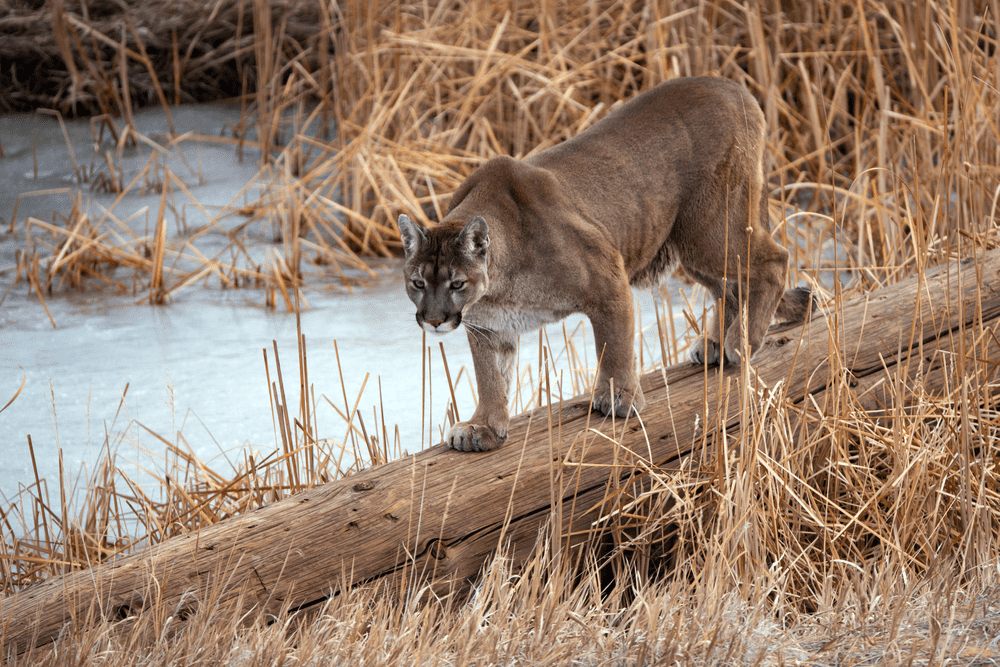
Cougars devour prey that lacks sufficient fluids to keep them alive. To stay hydrated, they still need fresh water. Cougars can live for days without drinking water, but they may ultimately require it.
Place in culture
The cougar’s grace and power have long been appreciated in the civilizations of the Americas’ indigenous peoples. The Inca city of Cusco is known to have been built in the shape of a cougar, and the animal was also given names by the Incas for both places and people. In their ceramics, the Moche people frequently depicted the cougar. Viracocha, the Inca’s sky and thunder god, has been linked to the animal.
In North America, legendary descriptions of the cougar have featured in stories told by the Winnebago language of Wisconsin and Illinois. The cougar’s cry is thought to be a sign of death to the Apache and Walapai people of the Southwest United States. The cougar is believed a holy animal among the Cherokee, but the Algonquins and Ojibwe believed it lived in the underworld and was wicked.
Conservation Status

The IUCN Red List has classified the cougar as Least Concern, and it is also included in CITES Appendix II. Panama, California, Honduras, Guatemala, Nicaragua, Costa Rica, Venezuela, Colombia, French Guiana, Suriname, Bolivia, Brazil, Chile, Paraguay, Uruguay, and the majority of Argentina forbid hunting. Mexico, the United States, Peru, and Canada all have hunting regulations. For cougar populations to thrive wildlife corridors must be established and appropriate range regions must be protected.
Although cougars are a resilient species and one of the greatest survivors among big cats, habitat fragmentation and anthropogenic activity may lead to its population decline. There are old and limited researches about the niche and territorial behavior of cougars and opportunity for an ecologist to explore various aspects to conserve this ecologically important and fantastic creature.
Read Also: What Are The 7 Big Cats In The World

